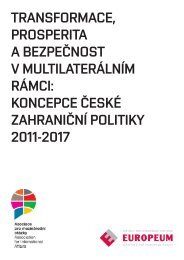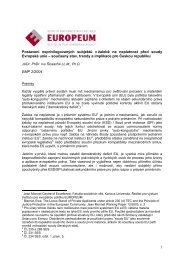eu constitutionalisation - EUROPEUM Institute for European Policy
eu constitutionalisation - EUROPEUM Institute for European Policy
eu constitutionalisation - EUROPEUM Institute for European Policy
You also want an ePaper? Increase the reach of your titles
YUMPU automatically turns print PDFs into web optimized ePapers that Google loves.
Chapter 6: A ‘saut constitutionnel’ out of an intergovernmental trap?enlargement” (Art. III-292 (1)) in order to offer “the best chance of pursuing…in awareness of their responsibilities towards future generations andthe Earth, the great venture which makes of it a special area of human hope”(Preamble TCE). The <strong>for</strong>mulations of the objectives, as indicators <strong>for</strong> identity,underline the notion that member states want and use the EU as a globalnorm-giver to promote universal values as a “cosmopolitan community”²⁴.This role definition of a global norm-giver is also stressed by the definition ofthe policy scope of the EU’s international ambition. In this regard, the IGCunderlines that “the Union’s competence… shall cover all areas of <strong>for</strong>eignpolicy and all questions relating to the Union’s security” (Art. I-16 (1)).With regard to mutual assistance clauses – such as Art. 5 of the NATO-Treaty – the IGC has adopted the following <strong>for</strong>mulations: They <strong>for</strong>eseea “progressive framing of a common defence policy that might lead toa common defence” (Art. I-16 (1)); in Art. I-41 (2) this <strong>for</strong>mula seems toincrease the political commitment by stating “this will lead to a commondefence”. Article I-41 (7) states a principle of mutual “obligation of aid andassistance by all the means in their power” in case of an “armed aggression”on the territory of a Member State. A reservation or limitation is added:“This shall not prejudice the specific character of the security and defencepolicy of certain member states.” The IGC has deleted the Convention’sArticle III-214 on “closer cooperation” which had opened unclear procedures<strong>for</strong> consultation in case of an attack. A special solidarity clause(Art. I-43 and Art. III-329) is introduced <strong>for</strong> cases of a “terrorist attack” ora “natural or man-made disaster” (Art. I-43 and Art. III-329).These <strong>for</strong>mulations of the document reflect a broad consensus on a dualidentity mixing ‘civilian’ power concepts with openings towards militaryinterventionism; if we also take other chapters of the TCE – such as thesymbols of the Union (Art. I-8) – the provisions <strong>for</strong> using military instrumentspoint at an ideational evolution which designs an identity of theEU as an international actor with state-like qualities. This is in line with themain objectives of the “<strong>European</strong> Security Strategy” (<strong>European</strong> Council2003) adopted by the heads of states and governments in December 2003.Overall the masters of the TCE have set the expectations <strong>for</strong> the Union’srole even higher and more comprehensive than be<strong>for</strong>e.24) SMITH (2004), p. 197.Chapter 6: A ‘saut constitutionnel’ out of an intergovernmental trap?3.2. Modest allocation of instruments:limited transfers of capabilitiesIn relation to the aspired objectives, the masters of the constitutionaltreaty have only marginally changed the provisions <strong>for</strong> the allocation ofcompetences and <strong>for</strong> legal instruments. The TCE has created a single “legalpersonality” (Art. I-7) which raises a set of difficult legal issues about thesupremacy of legal orders²⁵. Since the Court of the <strong>European</strong> Union shallhave no jurisdiction with respect to the articles governing the CFSP (Art.III-376) ambiguities created by this provision cannot be resolved by legalrulings; thus this intended ‘simplification’ of the pre-existing pillar structurewill inevitably lead to enduring controversial interpretations.In the allocation of the “Union’s competence” the CFSP (Art. I-16) was placedin between the “areas of shared competence“ (Art. I-14) and “areas of supporting,coordinating and complementary action“. (Art. I-17) Such a choice wasnot inevitable: The IGC might have put the CFSP into the category of sharedcompetence. This arrangement could have been done without pre-emptingnational sovereignty, as such a type of ‘parallel’ competence is used <strong>for</strong> developmentcooperation and humanitarian aid (Art. I-14 (4)); or the text mighthave allocated the CFSP to the “supporting, coordinating or supplementaryaction”, as this part of the external action should not harmonize the policy ofmember states by “legally binding acts” (Art. I-12 (5)). However, the TCE hascreated – or rather – kept the CFSP as a sui generis category²⁶. This interpretationis rein<strong>for</strong>ced by the provisions earmarking “specific provisions relating tothe CFSP” (Art. I-40) and to ESDP (Art. I-41). In contrast to these categoriesthe IGC has allocated e.g. the common commercial policy into the “area ofexclusive competence” (Art. I-13 (1e)). Thus behind some unifying façadeand slogans the traditional pillar structure continues to exist both in terms ofthe legal foundations and the procedures applied.Also in view of legal instruments the constitutional treaty even rein<strong>for</strong>cesthis dividing line; it deliberately excludes the application of <strong>European</strong> lawsand framework laws (Art. I-40 (6)), which are <strong>for</strong>eseen <strong>for</strong> legislative actsin other fields. Instead, the Union shall conduct the CFSP by defining the‘general guidelines’, adopting ‘<strong>European</strong> decisions’ defining ‘actions’ and25) CREMONA (2003), p. 1351.26) Ibid., p. 1354.204205








